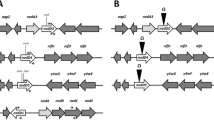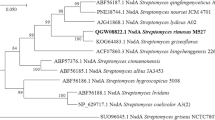Abstract
The quinate pathway is induced by quinate in the wild-type virulent Rhizoctonia solani isolate Rhs 1AP but is constitutive in the hypovirulent, M2 dsRNA-containing isolate Rhs 1A1. Constitutive expression of the quinate pathway results in downregulation of the shikimate pathway, which includes the pentafunctional arom gene in Rhs 1A1. The arom gene has 5,323 bp including five introns as opposed to a single intron found in arom in ascomycetes. A 199-bp upstream sequence has a GC box, no TATAA box, but two GTATTAGA repeats. The largest arom transcript is 5,108 nucleotides long, excluding the poly(A) tail. It contains an open reading frame of 4,857 bases, coding for a putative 1,618-residue pentafunctional AROM protein. A Kozak sequence (GCGCCATGG) is present between +127 and +135. The 5′-end of the arom mRNA includes two nucleotides (UA) that are not found in the genomic sequence, and are probably added post-transcriptionally. Size and sequence heterogeneity were observed at both 5′- and 3′-end of the mRNA. Northern blot and suppression subtractive hybridization analyses showed that presence of a low amount of quinate, inducer of the quinate pathway, resulted in increased levels of arom mRNA, consistent with the compensation effect observed in ascomycetes.







Similar content being viewed by others
References
Alexopoulos CJ, Mims CW, Blackwell M (1996) Introductory mycology, 4th edn. John Wiley, New York, 869 p
Bandy BP, Tavantzis SM (1990) Effect of hypovirulent Rhizoctonia solani on Rhizoctonia disease, growth, and development of potato. Am Potato J 67:189–199
Banerji SA, Wakefield E, Allen AG, Maskell DJ, Peters SE, Hopkin JM (1993) The cloning and characterization of the arom gene of Pneumocystis carini. J Gen Microbiol 139:2901–2914
Boosalis MG (1950) Studies on the parasitism of Rhizoctonia solani Kühn on soybeans. Phytopathology 40:820–831
Campbell SA, Richards TA, Mui EJ, Samuel BU, Coggins JR, McLeod R, Roberts CW (2004) A complete shikimate pathway in Toxoplasma gondii: an ancient eukaryotic innovation. Int J Parasitol 34(1):5–13
Carling DE (1996) Grouping in Rhizoctonia solani by hyphal anastomosis interactions. In: Sneh B, Jabaji-Hare S, Neate S, Dijst G (eds) Rhizoctonia species: taxonomy, molecular biology, ecology, pathology and disease control. Kluwer, Dordrecht, pp 37–47
Chamberlain VK, Wain RL (1971) Studies on plant growth-regulating substances-the influence of ring substituents on the plant growth regulating activity of phenylacetic acid. Ann Appl Biol 69:65–72
Charles IG, Keyte JW, Brammar WJ, Smith M, Hawkins AR (1986) The isolation and nucleotide sequence of the complex AROM locus of Aspergillus nidulans. Nucl Acids Res 14:2201–2213
Coggins JR, Boocock MR, Chaudhuri S, Lambert JM, Lumsden J, Nimmo GA, Smith DDS (1987a) The arom multifunctional enzyme from Neurospora crassa. Method Enzymol 142:325–341
Coggins JR, Duncan K, Anton IA, Boocock MR, Chaudhuri S, Lambert JM, Lewendon A, Millar G, Mousdale DM, Smith DDS (1987b) The anatomy of a multifunctional enzyme. Biochem Soc Trans 15:754–759
Davis RH, deSerres FJ (1970) Genetic and Microbiological Research Techniques for Neurospora crassa. Methods in Enzymology 17(a):79–143
Davis RH (1975) Compartmentalization and regulation of fungal metabolism: genetic approaches. Annual Review of Genetics 9:39–65
Diatchenko L, Lau YF, Campbell AP, Chenchik A, Moqadam F, Huang B, Lukyanov S, Lukyanov K, Gurskaya N, Sverdlov E.D, Siebert PD (1996) Suppression subtractive hybridization: a method for generating differentially regulated or tissue-specific cDNA probes and libraries. Proc Natl Acad Sci USA 93:6025–6030
Dujon B et al (2004) Genome evolution in yeasts. Nature 430:35–44
Duncan K, Edwards RM, Coggins JR (1987) The pentafunctional arom enzyme of Saccharomyces cerevisiae is a mosaic of monofunctional domains. Biochem J 246:375–386
Elliston JE (1982) Hypovirulence. Adv Plant Pathol 1:1–33
Frank JA, Francis SK (1976) The effect of a Rhizoctonia solani phytotoxin on potatoes. Can J Bot 54:2536–2540
Giles NH, Partridge CWH, Ahmed SE, Case ME (1967) The occurrence of the dehydroquinases in Neurospora crassa, one constitutive and one inducible. Proc Natl Acad Sci USA 58:1930–1937
Giles NH, Geever RF, Asch DK, Avalos J, Case ME (1991) Organizaton and regulation of the qa (quinic acid) genes in Neurospora crassa and other fungi. J Hered 82:1–7
Guo Z, Sherman F (1996) 3′-end-forming signals of yeast mRNA. Trends Biochem Sci 21:477–481
Hall TA (1999) BioEdit: a user-friendly biological sequence alignment editor and analysis program for Windows 95/98/NT. Nucl Acids Symp Ser 41:95–98
Hawkins AR, Giles NH, Kinghorn JR (1982) Genetical and biochemical aspects of quinate breakdown in the filamentous fungus Aspergillus nidulans. Biochem Genet 20:271–286
Hawkins AR, Lamb HK, Moore JD, Charles IG, Roberts CF (1993) The prechorismate (shikimate) and quinate pathways in filamentous fungi: theoretical and practical aspects. J Gen Microbiol 139:2891–2899
Hickok NJ, Seppanen PJ, Kontula KK, Janne PA, Bardin CW (1986) Two ornithine decarboxylase mRNA species in mouse kidney arise from size heterogeneity at their 3′ termini. Proc Natl Acad Sci USA 83:594–598
Huynh QK (1987) Reaction of 5-enolpyruvilshikimate-3-phosphate synthase with diethyl pyrocarbonate: evidence for an essential histidine residue. Arch Biochem Biophys 258:233–239
Jian J, Lakshman DK, Tavantzis SM (1997) Association of distinct double-stranded RNAs with enhanced or diminished virulence in Rhizoctonia solani infecting potato. Mol Plant Microbe Inter 10:1002–1009
Jianqiang M, Chirala SS, Wakil SJ (2003) Human acetyl-CoA carboxylase 1 gene: presence of three promoters and heterogeneity at the 5′-untranslated mRNA region. Proc Natl Acad Sci USA 100:7515–7520
Kozak M (1987) An analysis of 5′-noncoding sequences from 699 vertebrate messenger RNAs. Nucl Acids Res 15:8125–8148
Kumar S, Tamura K, Jakobsen IB, Nei M (2001) MEGA2: molecular evolutionary genetics analysis software. Bioinformatics 12:1244–1245
Lakshman DK, Jian J, Tavantzis SM (1998) A novel mitochondrial double-stranded RNA found in a hypovirulent strain of Rhizoctonia solani occurs in DNA form, and is phylogenetically related to the pentafunctional AROM protein of the shikimate pathway. Proc Natl Acad Sci USA 95:6425–6429
Lamb HK, van der Hombergh JPTW, Newton GH, Moore JD, Roberts CF, Hawkins AR (1992) Differential flux through the quinate and shikimate pathways: implications for the channeling hypothesis. Biochem J 284:181–187
Lamb HK, Newton GH, Levett LJ, Cairns E, Roberts CF, Hawkins AR (1996) The QUTA activator and QUTR repressor proteins of Aspergillus nidulans interact to regulate transcription of the quinate utilization pathway genes. Microbiology 142:1477–1490
Liu C, Lakshman DK, Tavantzis SM (2003a) Quinic acid induces hypovirulence, and expression of a hypovirulence-associated double-stranded RNA in Rhizoctonia solani. Curr Genet 43:103–111
Liu C, Lakshman DK, Tavantzis SM (2003b) Expression of a hypovirulence-causing double-stranded RNA (dsRNA) is associated with up-regulation of quinic acid pathway, and down-regulation of shikimic acid pathway in Rhizoctonia solani. Curr Genet 42:284–291
Logemann J, Schell J, Willmitzer L (1987) Improved method for the isolation of RNA from plant tissues. Anal Biochem 163:16–20
Marchler-Bauer A, Bryant SH (2004) CD-Search: protein domain annotations on the fly. Nucl Acids Res 32:W327–W331
Milborrow BV, Purse JG, Wightman F (1975) On the auxin activity of phenylacetic acid. Ann Bot 39:1143–1146
Padgette SR, Biest RED, Gasser CS, Eichholtz DA, Frazier RB, Hironaka CM, Levine EB, Shah DM, Fraley RT, Kishore GM (1991) Site-directed mutagenesis of a conserved region of the 5-enolpruvylshikimate-3-phosphate synthase active site. J Biol Chem 266:22364–22369
Pain A, Woodward J, Quail MA, Anderson MJ, Clark R, Collins M, Fosker N, Fraser A, Harris D, Larke N, Murphy L, Humphray S, O’Neil S, Pertea M, Price C, Rabbinowitsch E, Rajandream MA, Salzberg S, Saunders D, Seeger K, Sharp S, Warren T, Denning DW, Barrell B, Hall N (2004) Insight into the genome of Aspergillus fumigatus: analysis of a 922 kb region encompassing the nitrate assimilation gene cluster. Fungal Genet Biol 41(4):443–453
Parish T, Stoker NG (2002) The common aromatic amino acid biosynthesis pathway is essential in Mycobacterium tuberculosis. Microbiology 148:3069–3077
Pauws E, van Kampen1 AHC, van de Graaf SAR, de Vijlder JJM, Ris-Stalpers C (2001) Heterogeneity in polyadenylation cleavage sites in mammalian mRNA sequences: implications for SAGE analysis. Nucl Acids Res 29:1690–1694
Rossman MG, Moras D, Olsen KW (1974) Chemical and biological evolution of a nucleotide binding protein. Nature 250:194–199
Saitou N, Nei M (1987) The neighbor joining method: a new method for reconstructing phylogenetic trees. Mol Biol Evol 4:406–425
Sambrook J, Fritsch EF, Maniatis T (1989) Molecular cloning. A laboratory manual, 2nd edn. Cold Spring Harbor, New York
Sherwood RT, Lindberg CG (1962) Production of a phytotoxin by Rhizoctonia solani. Phytopathology 52:586–587
Shyamala V, Ferro-Luzzi Ames G (1993) Single specific primer-polymerase chain reaction (SSP-PCR) and genome walking. In: Bruce A (eds) PCR protocols current methods and applications, Chap 32, White. Humana Press, New Jersey, pp 339–348
Sneh B, Jabaji-Hare S, Neate S, Dijst G (eds) (1996) Rhizoctonia species: taxonomy, molecular biology, ecology, pathology and disease control. Kluwer, Dordrecht, 578 p
Strauss EE, Lakshman DK, Tavantzis SM (2000) Molecular characterization of the genome of a partitivirus from the basidiomycete Rhizoctonia solani. J Gen Virol 81:549–555
Tavantzis SM (ed) (2001) DsRNA genetic elements: concepts and applications in agriculture, forestry and medicine. CRC Press LLC, Boca Raton, 304 p
Tavantzis SM, Lakshman DK (1995) Virus-like double-stranded RNA elements and hypovirulence in phytopathogenic fungi, Chap 17. In: Kohmoto K, Singh RP, Singh US (eds) Pathogenesis and host-parasite specificity in plant disease: histopathological, biochemical, genetic and molecular basis, vol III. Elsevier (Pergamon) Press, Oxford, pp 249–267
Tavantzis SM, Perkins BL, Bushway RJ, Bandy BP (1989) Correlation between in vitro synthesis of phenylacetic acid and virulence in Rhizoctonia solani. Phytopathology 79:1199
Walker JE, Saraste M, Runswick MJ, Gay NJ (1982) Distantly related sequence in the α and β subunits of ATP synthase, myosin. Kinases, and other ATP- requiring enzymes and a common nucleotide binding fold. EMBO J 1:945–951
Ward DE, De Vos WM, Van Der Oost J (2002) Molecular analysis of the role of two aromatic aminotransferases and a broad-specificity aspartate aminotransferase in the aromatic amino acid metabolism of Pyrococcus furiosus. Archaea 1:133–141
Wood V et al (2002) The genome sequence of Schizosaccharomyces pombe. Nature 415:871–880
Wyllie TD (1962) Effect of metabolic by-products of Rhizoctonia solani on the roots of Chippewa soybean seedlings. Phytopathology 52:202–206
Author information
Authors and Affiliations
Corresponding author
Additional information
Communicated by U. Kück
Rights and permissions
About this article
Cite this article
Lakshman, D.K., Liu, C., Mishra, P.K. et al. Characterization of the arom gene in Rhizoctonia solani, and transcription patterns under stable and induced hypovirulence conditions. Curr Genet 49, 166–177 (2006). https://doi.org/10.1007/s00294-005-0005-6
Received:
Revised:
Accepted:
Published:
Issue Date:
DOI: https://doi.org/10.1007/s00294-005-0005-6




